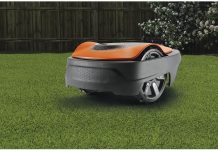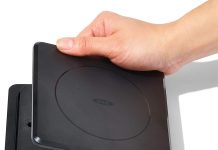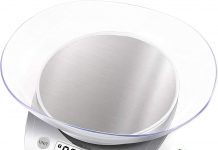The robotic lawnmowers are becoming increasingly popular as a hands-free alternative to traditional petrol and electric lawn mowers.
Most robot lawn mowers run off a rechargeable battery pack that keeps the mower cutting for a few hours at a time. Equipped with adjustable cutting blades and features like rain sensors and anti-theft pins, a robot mower can typically be controlled by a keypad on the mower, with many brands offering remote control via the app.
These robotic lawnmowers use a combination of sensors and border wiring that buyers manually plant around their yard to create zones where the mower travels. Today’s robot mowers are generally intelligent enough to return to their charging stations when their batteries run low (and, with certain models, when they detect rain).
Robotic mowers have another advantage over traditional lawn mowers. Their smaller cutting decks and lightweight razor blades require less motor power than full-size electric mowers and allow them to operate virtually silently. Some models, operate with as few as 56 decibels of sound output, quieter than a window-unit air conditioner.
Our top picks:
Flymo EasiLife 150 GO Robotic Lawn Mower
- Ideal for smaller gardens, the EasiLife 150 GO is a compact robotic lawn mower that automatically cuts up to 150m2 so you don’t have to – giving you a tidy lawn with zero effort.
- Mowing every corner of the lawn, the EasiLife 150 GO is packed with functions to suit your lifestyle and can automatically adapt its schedule based on the weather through LawnSense and FrostSense.
- No screens or complex programming, the LED indicators guide you for quick and easy control, with the Bluetooth app giving you full access to the robotic mowers extended settings – allowing you the set schedules and trouble shoot from the comfort of your home.
Worx Landroid M 20V Robotic Lawn Mower
- FULLY AUTOMATED: The Landroid M cuts up to a ¼ acre all by itself. Just lay down the boundary wire once, measure your lawn with the app, and let it mow.
- DO IT ALL WITH THE SAME BATTERY: Worx Power Share is compatible with all Worx 20v and 40v tools, outdoor power and lifestyle products.
- APP CONTROL: Check mowing progress, start or stop Landroid, receive software updates and more.
- NAVIGATES NARROW PATHS: Patented AIA technology allows Landroid to navigate narrow passageways too difficult for ordinary robotic mowers.
- CUSTOMIZED MOWING SCHEDULES: Have Landroid mow every day, every other day, it can even recommend an auto schedule based on your yard’s size and conditions.
WORX Landroid L WR155E Robot Lawn Mower for large gardens
- You only pay for the size you need. This model is perfect for large gardens up to 2000m2.
- Everything you need comes in the box, the mower has all the cables, wire and pegs you need for your size of lawn.
- The mower is plug and play. You don’t need to change settings if you don’t want to, it is pre-programmed with a schedule that suits your size of lawn but can be easily adjusted on the machine or via the App on your phone, from anywhere.
- Agile and smarter due to intelligent AIA technology, the turning pattern means it cuts your lawn 30% faster than other robot mowers, and doesn’t wear the edges of your lawn like others do with their continual reversing.
Gardena Robotic lawnmower up to 300m² lawn area
- The mower can be operated with the GARDENA Bluetooth app from a distance of up to 10 m. Programs: EasyApp Control, Auto Schedule and EasyConfig for easy installation and operation.
- SensorCut System: Mows streak-free and evenly from different directions, ideally suited for small and medium-sized gardens with a lawn area of up to 300 m².
- Waterproof operation: the robotic lawnmower also mows when it rains and thus ensures a perfect lawn carpet; if it gets dirty, the robot can be easily cleaned with the garden hose.
- EasyPassage: guides the robot through narrow corridors. Maximum incline: 35%
Gardena robotic lawnmower SILENO city 600 m²
- Settings via the app: The mower can be programmed from up to 10 m away via the Gardena Bluetooth app (online registration required) for lawns up to 600 m²
- AI for accuracy: Narrow passages and tight corners are no obstacle for the SILENO city. These are detected independently and cut with reliable precision.
- Weather-proof: The robotic lawnmower is water-resistant and can be used in windy and adverse weather conditions. This means there is no need to stop the mowing programme due to rain
- Very quiet: While mowing the lawn, you and your neighbours can relax in the garden without disturbing noise, as at only 57 dB(A), the SILENO city is extremely quiet, so it will not bother anyone
Yard Force Compact 400Ri Robotic Lawnmower
- 400m² working area suitable for city gardens
- iRadar – Active Safety Ultrasonic Sensor Technology
- App control – intelligent technology enables control from any location
- Brushless Motor with 20V Lithium-Ion Samsung battery and 16cm cutting width
- Sharp blades create mulching for a healthier looking lawn, variable cutting heights ranging 20-55mm
- Built-in lift, obstacle, turnover, tilt & rain sensors; tackles incline up to 30%
Yard Force Compact 300RBS Robotic Lawnmower
- 300m² working area suitable for city gardens
- iRadar – Active Safety Ultrasonic Sensor technology, the most advanced feature in robotic mowing
- Full App control via Bluetooth connection
- Brushless Motor with 20V Lithium-Ion Samsung battery and 16cm cutting width
- Sharp blades create mulching for a healthier-looking lawn, variable cutting heights ranging 20-55mm
- Rain sensor enables Compact 300RB to go back to the charging station automatically
- Additional protection with built-in sensors: lift, obstacle, turnover, tilt; tackles inclines up to 30%
Flymo EasiLife 800 Robotic Lawn Mower
- Ideal for medium to large gardens, the EasiLife 800 is a robotic lawn mower that automatically cuts up to 800m2 so you don’t have to – giving you a tidy lawn with zero effort.
- Mowing every corner of the lawn, the EasiLife 800 is packed with functions to suit your lifestyle and can automatically adapt its schedule based on the weather through LawnSense and FrostSense
- Schedule when you want with the Bluetooth app, giving you full access to the robotic mowers extended settings, allowing you the set schedules and trouble shoot from the comfort of your home.
- Ultra quiet mowing at 58dB(A) means that you won’t disturb you or your neighbours when your robotic is mowing, allowing you to keep to a regular mowing schedule for a healthy greener lawn.
How to choose the right robot lawn mowers for your garden?
There are five key factors for you to choose the mower that is best for your garden.
1. Smartphone app
During our tests, we look at how easy it is to use the app that comes with some of these robot mowers – we’ve found they range from limited to one operating system, to versatile and simple to use. You’ll find it reasonably simple to use an app, assuming it works with your smartphone, rather than fiddle with the onboard controls.
Whether you need to use the app really depends on how autonomous the robot mower is. If it comes with sensors that detect rain, then you won’t need to reschedule. No mower cuts particularly efficiently in wet grass.
Some apps will allow you to set up a map of your garden so the mower knows where to go rather than in a random fashion, and some will allow you to see whether the robot mower is currently in action.
Unfortunately it’s not all roses with an app – some will only work with one type of smartphone, Apple or Android, and others might use Bluetooth rather than Wi-Fi so you’ll need to be closer to the robot mower to connect with it. In some cases the app might be an additional extra on top of an already expensive robot mower.
2. Lawn size
We’ve seen robot lawnMowers suitable for lawns of up to 5000sqm, and as small as 250sqm. The maximum we’ve tested was 3000sqm and our testers generally agree with those manufacturer recommendations for maximum lawn size. If you select a robot lawnmower too small for your lawn size, you’re likely to run out of guard wire or the mower is going to run out of puff based on its battery size. Generally manufacturers recommend buying one that’s suitable for a yard a little larger than your own.
3. Slopes and uneven lawns
As robotic lawn mowers are powered by batteries, and they don’t have a human behind them making sure they can get up a slope or avoid a dip, it’s a good idea to pay attention to the slope that these mowers claim they’re able to cope with. They’ll give you the slope angle in degrees but the flatter the better.
An uneven lawn means dips. While we test how easily the mowers manage these dips and strange gradients that are in every lawn, the flatter your lawn, the more likely the mower is to be able to make a full round of your lawn. If the dip is significant, you might consider filling it in, or putting a barrier around it and investing in a sensor for the robot lawnmower so it can avoid it.
4. Sensors
Rain sensors
No mower cuts well in the wet, and robot lawn mowers are no exception. A rain sensor can be an optional extra or come with the product by default. A rain sensor will trigger off a variety of options, depending on the brand and model. It might make the robot lawnmower skip a scheduled mow, or it might alert you and ask if you want to continue with the schedule.
Obstacle sensors
They aren’t just for rain though, as many robotic lawnmowers have sensors for anything they encounter. If you have trees, bushes or other obstacles that can’t be removed before the robotic lawn mower starts off, they’ll generally avoid these elements, just as a robot vac would in the house.
Multi-zone
Want your robotic lawn mower to mow both the front and back lawns? You might need a multi-zone mower, so you can program both lawn sizes and design. You’ll have to carry or wheel the robot lawnmower between the two spaces, as they aren’t smart enough to move themselves there – yet.
5. Battery life
The most expensive element of any mower will be the battery, and these are larger depending on the size of your lawn you want it to cover. All of the ones we’ve tested are lithium-ion. Check in with the manufacturer prior to buying to see how long they’ll stock the batteries and how much they are (they can be an expensive replacement) and like all lithium-ion batteries you’ll start to see slow degradation over time, which will be the robot mower returning to its base unit more frequently for recharging.
You can expect batteries for robotic lawnmowers to last at least 2–5 years, depending on a number of environmental conditions such as heat and cold, how often your robot needs to cut the grass, when you’re cutting and whether it’s stored out of direct heat.

























